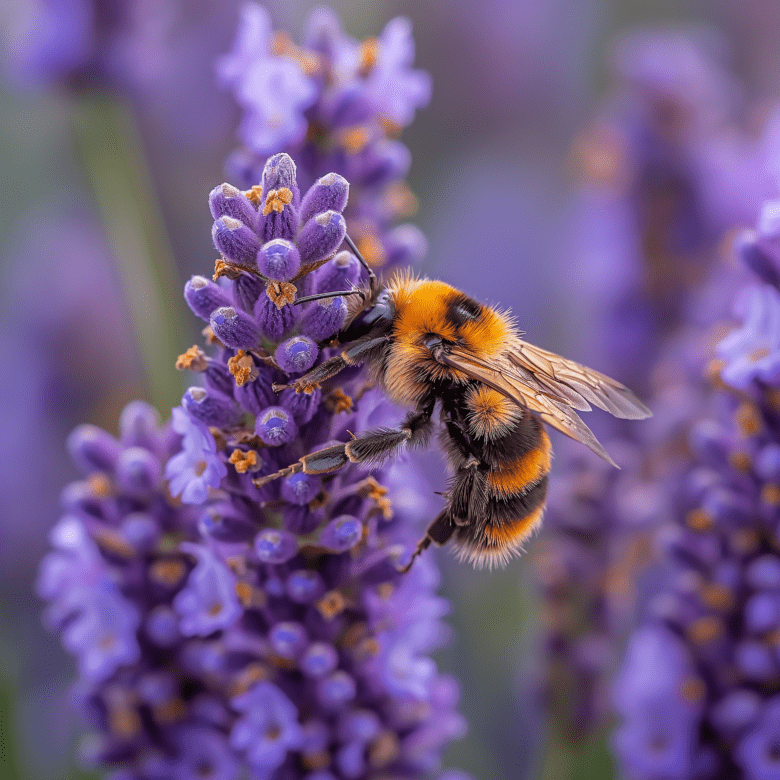Bees play a crucial role in the health and productivity of your garden. Their significance extends far beyond their role as mere insects; they are essential pollinators that contribute to the vitality of both your garden and the broader ecosystem. Understanding the benefits of bees can help you appreciate their value and motivate you to create an inviting environment for them.
Pollination Powerhouses
One of the most significant contributions of bees to your garden is their role in pollination. Pollination is the process by which bees transfer pollen from one flower to another, enabling plants to reproduce. This process is essential for the production of fruits, vegetables, and seeds. Without bees, many plants would struggle to reproduce, leading to lower yields and a reduction in the variety of produce you can grow.
Bees are particularly effective pollinators due to their foraging habits. As they visit flowers to collect nectar and pollen, they inadvertently transfer pollen between blooms, facilitating cross-pollination. This cross-pollination enhances genetic diversity in plants, which can lead to healthier and more resilient crops. For gardeners, this means more bountiful harvests and a vibrant array of plant life.
Supporting Biodiversity
Beyond their direct impact on plant reproduction, bees also support broader biodiversity in your garden. A garden that attracts bees is likely to host a variety of plants, including those that may not typically grow well without their pollination. This diversity can create a more balanced and resilient ecosystem, which benefits other wildlife and contributes to the overall health of your garden.
Moreover, bees themselves are part of a larger web of life. They provide food for various predators, including birds and other insects. By supporting bee populations, you are indirectly supporting the entire food chain, which contributes to a thriving and balanced garden ecosystem.
Conserving Bee Populations
In recent years, bee populations have faced significant challenges, including habitat loss, pesticide exposure, and disease. By making your garden bee-friendly, you can contribute to the conservation of these vital insects. Creating a habitat that supports bees not only benefits your garden but also helps sustain bee populations, which are crucial for global food security and environmental health.
In conclusion, attracting bees to your garden is not just about enhancing your garden’s productivity; it’s about supporting a critical component of our ecosystem. By understanding and appreciating the role of bees, you can take meaningful steps to create a welcoming environment for them, leading to a more vibrant and healthy garden.
Understanding Bees: Types and Behaviors
Main Types of Bees and Their Characteristics
Bees come in various shapes and sizes, each with unique roles and behaviors. Understanding the different types can help you create a more effective bee-friendly garden. Here are some of the main types:
– Honey Bees: These are the most well-known bees and are crucial for commercial agriculture. They live in colonies and produce honey, which they store in wax cells. Honey bees are excellent pollinators for a wide range of plants.
– Bumble Bees: Larger than honey bees, bumble bees are effective pollinators, especially for plants with tubular flowers. They can forage in cooler temperatures and are essential for pollinating crops like tomatoes and blueberries.
– Solitary Bees: Unlike honey and bumble bees, solitary bees do not live in colonies. Each female builds her own nest and provisions it with pollen and nectar for her offspring. Solitary bees are highly efficient pollinators and include species like mason bees and leafcutter bees.
Bee Behaviors Affecting Pollination
Bees exhibit several behaviors that directly impact their pollination effectiveness:
– Foraging Patterns: Bees tend to visit a variety of flowers in a specific area, which helps in cross-pollination. They remember the location of flowers, making them efficient in pollinating plants within their range.
– Flower Preferences: Different bees have different preferences for flower types, colors, and shapes. For example, honey bees prefer blue and purple flowers, while bumble bees are attracted to red and pink blooms.
– Nectar and Pollen Collection: Bees collect nectar and pollen as they visit flowers. The pollen sticks to their bodies and is transferred from one flower to another, facilitating pollination. They also communicate with each other about the location of nectar sources through dances.
Planning Your Garden to Attract Bees
Choosing the Ideal Location in Your Garden
Selecting the right location for your bee-friendly garden is essential:
– Sun Exposure: Bees prefer sunny areas where they can easily find nectar. Ensure that your garden gets ample sunlight throughout the day.
– Shelter from Wind: Wind can make it difficult for bees to forage. Position your garden in a sheltered area or provide natural windbreaks, such as hedges or fences.
– Water Source: Bees need water for drinking and cooling their hives. Including a shallow water source, like a birdbath or a small pond, can attract bees to your garden.
Creating a Bee-Friendly Environment
To make your garden more inviting to bees:
– Avoid Pesticides: Pesticides can harm bees. Opt for natural pest control methods and use organic or non-toxic alternatives.
– Diverse Planting: Include a variety of plants that bloom at different times of the year to provide a continuous food source for bees.
– Bee Hotels: Installing bee hotels can provide nesting sites for solitary bees, which often lack natural nesting sites in urban gardens.
**Planting Flowers and Plants Attractive to Bees**
**Best Flowers and Plants to Attract Bees**
Some plants are particularly attractive to bees due to their nectar and pollen content. Consider adding the following to your garden:
– Lavender: Known for its fragrant blooms, lavender is a favorite among bees for its abundant nectar.
– Sunflowers: These large, bright flowers provide ample pollen and are visually appealing to bees.
– Bee Balm: As its name suggests, bee balm is excellent for attracting bees. It produces vibrant, tubular flowers that bees find irresistible.
Types of Plants Providing Nectar and Pollen
In addition to specific flowers, include plants that provide nectar and pollen throughout the growing season:
– Herbs: Plants like mint, thyme, and rosemary are not only useful in the kitchen but also attract bees with their small, fragrant flowers.
– Wildflowers: Planting a mix of native wildflowers can offer a variety of nectar sources and support local bee populations.
**Creating Shelters and Nests for Bees**
**How to Build or Install Shelters for Solitary Bees**
Creating habitats for solitary bees can enhance your garden’s appeal to these important pollinators:
– Bee Nests: Construct bee nests using bamboo tubes or wooden blocks with drilled holes. These provide nesting sites for solitary bees like mason bees.
– Twig Bundles: Bundles of twigs or branches can also serve as nesting sites for various solitary bee species.
**Benefits of Having a Bee Hotel in Your Garden**
Bee hotels offer several advantages:
– Support for Solitary Bees: Bee hotels help provide critical nesting sites, especially in urban areas where natural habitats may be scarce.
– Educational Value: Observing bees using these hotels can be a great educational experience for children and adults alike.
**Gardening Practices That Benefit Bees**
**Using Pesticides and Safe Alternatives**
– Minimize Chemical Use: Avoid using pesticides and herbicides whenever possible. These chemicals can be harmful to bees and other beneficial insects.
– Natural Pest Control: Use natural predators, such as ladybugs and lacewings, to control pests in your garden.
**Avoiding Practices Harmful to Bees**
– Avoid Over-Watering: Excessive watering can drown bee nests and disrupt the soil structure that bees rely on.
– Promote Biodiversity: Encourage a diverse range of plants to create a healthy environment that supports various pollinators.
**Maintenance and Ongoing Care**
**Maintaining Plants and Bee Habitats**
Regular maintenance is key to keeping your garden bee-friendly:
– Regular Pruning: Prune plants to encourage healthy growth and remove any dead or diseased parts.
– Checking Bee Hotels: Periodically inspect and clean bee hotels to ensure they remain inviting and functional for solitary bees.
**Monitoring and Improving Garden Health for Bees**
– Observe Bee Activity: Pay attention to the types of bees visiting your garden and their behaviors. This can help you understand what works and make adjustments as needed.
– Continual Improvement: Experiment with different plants and garden features to create the most welcoming environment for bees.
By following these guidelines, you can create a thriving, bee-friendly garden that supports the health of these vital pollinators and enhances the overall beauty and productivity of your outdoor space.
The Benefits of a Bee-Friendly Garden
Creating a garden that attracts and supports bees offers numerous benefits, both for your garden and the broader environment. By implementing bee-friendly practices, you contribute to the health and vitality of your garden, while also supporting the crucial role bees play in our ecosystems.
**Summary of Benefits**
1. **Enhanced Pollination**: One of the most significant benefits of attracting bees is the boost to pollination. Bees are excellent pollinators, helping to fertilize plants and promote the production of fruits, vegetables, and seeds. This not only results in a more bountiful harvest but also ensures a diverse range of plants in your garden.
2. **Increased Biodiversity**: A bee-friendly garden tends to be more diverse, as bees attract a variety of flowering plants. This diversity enhances the overall health of your garden, supports other wildlife, and creates a more vibrant and resilient ecosystem.
3. **Environmental Conservation**: By creating habitats for bees, you contribute to their conservation. Many bee populations are currently under threat due to habitat loss, pesticides, and disease. Your efforts help provide critical resources and safe spaces for these important pollinators, aiding in their survival and well-being.
4. **Educational Value**: A garden that supports bees can serve as an educational tool for you and your family. Observing bees in action, learning about their behaviors, and understanding their role in the environment can foster a deeper appreciation for nature and the interconnectedness of ecosystems.
5. **Sustainable Gardening**: Bee-friendly gardening often aligns with sustainable practices, such as using organic methods and reducing chemical use. This approach benefits not only bees but also the overall health of your garden and the environment.
**Encouragement to Implement Tips**
Now that you understand the myriad benefits of attracting bees to your garden, it’s time to put this knowledge into action. Start by selecting bee-friendly plants, creating habitats, and adopting practices that support bee health. Even small changes can make a significant difference.
Consider incorporating a variety of flowering plants that provide nectar and pollen throughout the year, building or installing bee hotels, and minimizing the use of harmful chemicals. Each step you take will contribute to a more inviting and supportive environment for bees.
By making your garden a haven for bees, you are not only enhancing its beauty and productivity but also playing a part in the conservation of these vital pollinators. Embrace these practices and watch as your garden flourishes with the buzz of happy, healthy bees. Your efforts will have lasting impacts, both for your garden and the wider world.

Hi, I’m James Stevan, an avid beekeeper with over a decade of experience in apiculture. My passion for bees drives me to share practical tips and insights on sustainable beekeeping. Join me as we explore the fascinating world of bees and their crucial role in our ecosystem.




